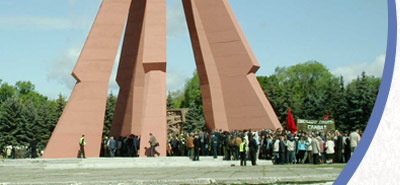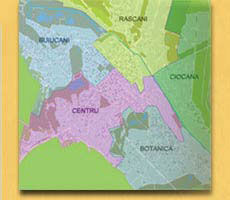

Saharna
You can't find anywhere in the world more picturesque, generous and with tempting lands as in Saharna. Here you'll find harmoniously bound the vineyards, orchards and woods, the calm and restful water of Dnestr, the raging and foamy waterfalls from narrow paths, the bald and abrupt rocks that are raising proudly to the sky. Everywhere you go the charming milieu of a little paradise goes with you.
The village Saharna has its roots in the depth of the centuries. It is mentioned for the first time in 1495, even the hearth fire of this community was lightened before Christ. After the archeological excavations here were found two necropolis from the 8-6 centuries BC. On a hillock near the old riverbed of the Dnestr were found also two fortresses with aqueduct from clay tubes, old settlements called hillocks. Once the Byzantine, Greek and Roman commercial ships cast their anchors on the locality's gateways, the suitors from Iashi, Podolia, Kiev and Poltava came to the Saharna's fairs. This decent settlement was attacked by the Huns and Tartars, by Poles and Ottomans. The forests and abrupt rocks served to our ancestors as fortress. From here groups of horsemen were dashing in the battles under the victorious banners of Stephen the Great, defending the east boundaries of our country. The Holy Scriptures were always and everywhere near to our brave soldiers in their long and bitter fight against the pagans. As a testimony can serve the chronicles, the monastic ensemble from Saharna, situated in a deep valley, watched by the vigourous ridges of rocks.
From Rezina on a distance of seven km downstream the Dnestr you are accompanied to the left by the magestic river, that shines in the sun, to the right - the high bank with massive rocks, stray trees and haughty groves painted in fall's colours. You are welcomed to the entrance of the village by a stately charming aspen, master on a group of willows, that wash their long hair in the purling of rivulet Saharna. From the Grimidon rock the road suddenly turns to the right, goes near the gates of householders, climbs the hill, than descends to the Holy Trinity Monastery. The monastic complex and the natural reservation that has an area of 670 ha are taken under the state protection. The rivulet Saharna on his course of near 10 km descends the thresholds of 22 cascades, creating in his wonderful reign of trees and flowers a unique microclimate rich in oxygen. You can drink the cold and clear water, breathe the flavour of luxuriant vegetation and you feel the invisible force that gives you health and strength. Our ancestors knew where to built the soul's sanctuary, where to heal their bodies and how to soothe their grief.
There are left few testimonies of the events sifted in time. The documents that exist in the archive give us the possibility to find out something about the past epochs.
The book "Bessarabian Monasteries", written by V.Puiu and edited in 1919 in Chisinau, you can read the following description: " This monastery is situated on the bank of Dnestr at a distance of 45 km from the city Orhei. It is settled between three narrow valleys, surrounded by rocky heights and with a beautiful view on the Ukraine. Before here was a hermitage named Horodishte, with the church built in rock and some rooms. In 1776 the monk Bartolomeu came from Russia with some brothers and monks and found the hermitage uninhabited. They repaired the church, the rooms and settled here. Later, helped by the landlord Enache Hrisoverghi Lazu, that lived mostly in Iashi, he endowed the hermitage with 200 tithes of land.
In 1818 the abbot Paisie begin to built from stone the big summer church. It is finished in 1821 by the abbot Tarasie and is sanctified with the festival "Holy Trinity" by metropolitan bishop Veniamin of Moldova. In 1837 the abbot Onisifor renovated the iconostasis and built houses from stone for the disciples.
In 1883 the abbot Serafim built one more church, the winter one, with a block of flats for priests and a block near the summer church.
In 1900 the abbot Iosif built houses from stone, besides the courtyard for the mill and lumber rooms; in 1911 under the abbacy of the hieromonk Inochentie were built the block of houses where is the xenodochium, the lumber rooms for the bread and a block of rooms for the brothers.
Today the monastery has 160 tithes of land, a fire mill and a beautiful farmstead. In 1918 here were: abbot Sofronie Neaga, 11 hiermonks, 4 hierodeacon, 10 deacon and 34 brothers."
The collection of documents "Bessarabia" (P.Crusevan,1903, Moscow) says that the monk Bartolomeu found Saharna's hermitage abandoned. He repaired the cells, adorned them with icons, put some candles, started to pray. The monastery from rock was opened again in 1776. Among the treasures that were kept here you could find: a big cross from cypress gilt with silver, an epitaph sewn with gold and precious stones, a splendid Gospel wrapped with gold and silver and enamels with turquoise. This holy objects were donated to the monastery by Cossacks from Don in 1817 when they were on their way home from the war with Napoleon.
At the beginning of our century the monastery's estate has 160 tithes of land, granaries, vineyards and orchards, three mills, herd of sheep, caws, horses and apiaries. The purification of mind and soul was done not only by beads, but also by ungrudgingly work. There was a school of agronomy for five decades in Saharna, as well as a workshop of ceramics and craftsmanship for folk architecture. Their founder N.C.Apostolopulo (dead in 1901) has his sleep of the brave under a granite tombstone in the monastery's courtyard.
In our days there are done restoration workings at the monastic complex Saharna with the help of the population and the Government of the Republic of Moldova.
The complex had a tragic destiny in the '60s, but it regained the status of monastery at 1october 1990. In Saharna the bells ring again!
Saharna monastery, with its festival "The Holy Trinity", day's angel on 8 September, has 20 monks and brothers, abbot - archimandrite Andrian (Iurie Baciu). It was closed in 1964 and opened in 1991. It is situated at a distance of 8 km from Rezina and 14 km from the nearest station Ribnitsa.
(Source: www.old.ournet.md)










